
Galactic Turbulence: Shocking Discoveries Set to Rewrite Cosmic Theory!
2025-05-14
Author: Wei
Galactic turbulence—a cosmic force that significantly influences star formation and particle movement—has just been analyzed like never before, resulting in groundbreaking findings that challenge established scientific theories.
From the crashing waves of the ocean to the choppy skies experienced on a flight, turbulence is a familiar force in our world. It breaks larger waves into smaller, cascading energy across varied scales. This same chaos exists throughout our Galaxy and the universe, controlling the behavior of plasma, stars, and magnetic fields alike.
Despite the widespread presence of turbulence, it remains one of the most perplexing mysteries in physics. Recently, a diverse international team of scientists has made monumental strides in deciphering this phenomenon by creating the largest simulations ever of magnetized turbulence. Their astonishing results indicate that galactic energy flows in ways that directly contradict long-held theories.
Unveiling the Secrets of Turbulent Galaxies
Leading the groundbreaking study is James Beattie, a postdoctoral researcher affiliated with Princeton University and the University of Toronto, working alongside Amitava Bhattacharjee and experts from several prestigious institutions. Their cutting-edge simulations have provided an unparalleled insight into the turbulent core of our Galaxy. Remarkably, their findings reveal significant breaches in models that have traditionally shaped astrophysical theories.
One critical insight from their research underscores the vital influence of magnetic fields on turbulence within the interstellar medium—the immense space between stars. The team's simulations convincingly demonstrated that magnetic fields dramatically modify energy flow, hindering smaller-scale motions while enhancing specific wave disturbances known as Alfvén waves. This revelation could transform our fundamental grasp of the Galaxy's turbulent structure, the dynamics of high-energy particle transport, and even star formation processes.
Implications for Space Exploration and Safety
The consequences of this research extend far beyond theoretical physics; they hold tangible implications for the future of space exploration. As commercial spaceflight grows more prevalent, mastering the intricacies of galactic turbulence and the generation of high-energy particles becomes essential.
Co-author Bhattacharjee, a Professor of Astrophysical Sciences at Princeton, shared that this research could vastly improve our predictions regarding space weather. An enhanced understanding of the plasma environment surrounding satellites and future missions is crucial for safeguarding equipment and protecting lives from the threatening effects of energetic particles. Moreover, this study sheds light on the mysteries of cosmic magnetic fields, offering vital context for navigation and interpretation of future NASA missions.
An Unprecedented Computational Achievement
The sheer scale of the simulations conducted is awe-inspiring. To accurately replicate the complex dynamics of space turbulence—far more intricate than on Earth due to magnetic fields—the researchers utilized an incredible network of 140,000 computers working in unison.
Beattie highlighted the enormity of this computational feat, stating, "If we had started a simulation on a single laptop when humankind first domesticated animals, it would just now be finishing up!" He attributed their success to the remarkable capabilities provided at the Leibniz Supercomputing Centre.
Published in the journal Nature Astronomy, this research marks a major advancement in our goal to decipher turbulence mysteries. By pushing the limits of computational simulation, these scientists are forging a path towards a deeper understanding of the universe, from Earth's chaotic plasma to the widespread turbulent motions throughout the Galaxy and beyond. Their ultimate goal? To unveil universal features of galactic turbulence that resonate across the cosmos, a challenge they remain steadfastly committed to with future simulations.


 Brasil (PT)
Brasil (PT)
 Canada (EN)
Canada (EN)
 Chile (ES)
Chile (ES)
 Česko (CS)
Česko (CS)
 대한민국 (KO)
대한민국 (KO)
 España (ES)
España (ES)
 France (FR)
France (FR)
 Hong Kong (EN)
Hong Kong (EN)
 Italia (IT)
Italia (IT)
 日本 (JA)
日本 (JA)
 Magyarország (HU)
Magyarország (HU)
 Norge (NO)
Norge (NO)
 Polska (PL)
Polska (PL)
 Schweiz (DE)
Schweiz (DE)
 Singapore (EN)
Singapore (EN)
 Sverige (SV)
Sverige (SV)
 Suomi (FI)
Suomi (FI)
 Türkiye (TR)
Türkiye (TR)
 الإمارات العربية المتحدة (AR)
الإمارات العربية المتحدة (AR)